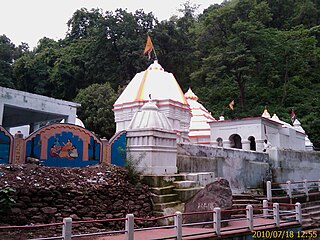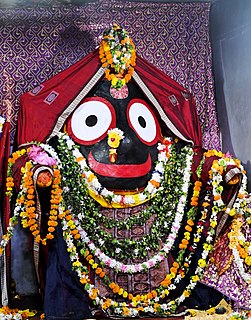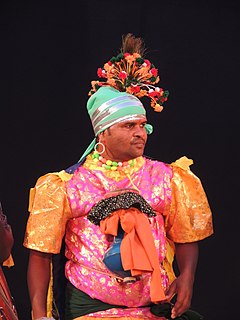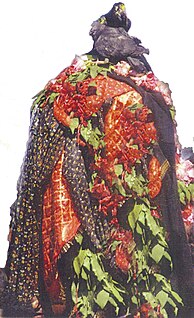
Odisha, formerly Orissa, is an Indian state located in Eastern India. It is the 8th largest state by area, and the 11th largest by population. The state has the third largest population of Scheduled Tribes in India. It neighbours the states of Jharkhand and West Bengal to the north, Chhattisgarh to the west, and Andhra Pradesh to the south. Odisha has a coastline of 485 kilometres (301 mi) along the Bay of Bengal in Indian Ocean. The region is also known as Utkala and is also mentioned in India's national anthem, "Jana Gana Mana". The language of Odisha is Odia, which is one of the Classical Languages of India.

Balangir District, also called Bolangir District, is a district situated in western Odisha state of India. The district has an area of 6,575 km2 (2,539 sq mi), and a population of 1,648,997. The town of Balangir is the district headquarters. The composition of the land is predominantly rural. Other important big & small towns in Balangir district are Titlagarh, Patnagarh, Kantabanji, Loisingha, Saintala, Belpada, Tushra, Agalpur, Deogaon, Chudapali, Biripali, Bhalumunda, Bangomunda, Sindhekela, Turekela and Muribahal.

Kalahandi is a district of Odisha in India. Archaeological evidence of Stone Age and Iron Age human settlement has been recovered from the region. Asurgarh offered an advanced, well civilised, cultured and urban human settlement about 2000 years ago in the region. In South Asia it is believed that the lands of Kalahandi district and Koraput district were the ancient places where people started cultivation of paddy. In ancient time it was known as Mahakantara and Karunda Mandal, which means treasure of precious stones like karandam (corundum/manik), garnet, beruz, neelam, and alexandrite, etc. Manikeswari is the clan deity of Kalahandi may also signify its historical name.

Paralakhemundi is district Headquarter of Gajapati district and one of the oldest Municipality established in 1885, in the Indian state of Odisha. Majority of the people in the town speak Odia. The city and the District share its boundaries with Andhra Pradesh. Pathapatnam /Purunapatana town in the Srikakulam District of Andhra Pradesh is considered as twin city to Paralakhemundi due to its very close proximity. The adjacent towns are separated by the River Mahendra Tanaya. The town is well known for being an ancient cultural center of Odisha and eminent personalities such as the 18th-century Odissi musician-poet Gopalakrusna Pattanayaka, founding father of Odisha state Maharaja Krushna Chandra Gajapati Narayan Deo ,and eminent Indian Historian Padmasri Dr Satyanarayana Rajguru belong to the city. This is known as Temple town and Palace town of southern Odisha

Bhawanipatna is a city, and district headquarters of the Kalahandi district, in the Indian state of Odisha. Bhawanipatna is a city of numerous temples dedicated to different deities of the Hindu pantheon. It is named after the presiding deity, Bhawani-Shankar and Patna which means "place" in Odia like "Padaa". Bhawanipatna municipality is the administrative head of the city, which is divided into twenty wards with different sub-areas called pada. Originally, these padaas were inhabited by people of different communities, but over the last few decades, these padaas have become homogeneous. Bhawanipatna has more than forty padaas.
Junagarh is a town and a notified area council in Kalahandi district in the Indian state of Odisha. MLA of Junagarh is Captain Divya Shankar Mishra. It was the capital of the former state of Kalahandi. Junagarh is 26 km from Bhawanipatna, connecting National Highway 201.This highway recently has been termed as National Highway 26.

Manikeshwari Temple is located in Kalahandi district of Odisha, India. The temple is located to the south of Bhawanipatna. The main deity here is Goddess Manikeshwari. She is the Ishta Devi of Nagavanshi Khyatriya's. During Dussehra festival, animal sacrifice is offered at this temple. A film is also documented showing the ritual of animal sacrifice, before Goddess Manikeshwari. Karlapat, which is famous for its charming wild life, is near the temple.
The history of Kalahandi goes back to the primitive period where a well-civilized, urbanized, and cultured people inhabited this land mass around 2000 years ago. The world's largest celt of Stone Age and the largest cemetery of the megalithic age have been discovered in Kalahandi. This shows the region had a civilized culture since the pre-historic era. Asurgarh near Narla in Kalahandi was one of the oldest metropolises in Odisha whereas the other one was Sisupalgarh near Bhubaneswar. Some other historical forts in the region includes Budhigarh, Amthagarh, Belkhandi and Dadpur-Jajjaldeypur. This land was unconquered by the great Ashoka, who fought the great Kalinga War, as per Ashokan record. In medieval period the region had played a prominent role to link South India, Eastern India and Central India region and witnessed the battle ground for Somavamsi, Chola, Kalachuris of Kalyani and Eastern Ganga dynasty. Kalahandi region was the main route for Chola to attack Subarnapur.
Festivals of Kalahandi are rich in nature as the place is a melting point of South Odisha and Western Odisha. Kalahandi, a district of Odisha, shelters a substantial tribal population residing both in hills and plain land. It is a place where people of different cultures, traditions, languages and beliefs live together.

Ghumura dance is a folk dance of Kalahandi district of the Indian state Odisha. It is classified as folk dance as the dress code of Ghumura resembles more like a tribal dance, but there are arguments about mudra and dance forms of Ghumura bearing more resemblance with other classical dance forms of India.

Krushna Chandra Gajapati KCIE, also known as Maharaja Sir Sri Sri Sri Krushna Chandra Gajapati Narayana Deba, was a key personality and regarded as the architect, founding father of an Independent united Odisha State. He was a scion of Paralakhemundi zamindari of then Ganjam district and the owner of Delanga estate of Puri district. His family belong to the great Eastern Ganga Dynasty .He was the first Prime Minister of Orissa. The present-day Gajapati District of Odisha was named after him.
Bhawanipatna is classified as one of the major tourist destinations by the tourism Department of Government of Odisha. All the tourist attraction in Kalahandi region comes under Bhawanipatna jurisdiction. Though tourist potential of Kalahandi has not been exploited optimally due to poor marketing, political negligence and infrastructure development, the land is very rich in terms of water fall, forest and wild life, natural and scenic beauty, tribal life, mountains, agriculture field, historical sites and handicrafts. The best time to visit Kalahandi region is from October to March. April–June is hard Summer and the mercury may rise to 45 degree C and June to August is the Monsoon Season. It occasionally rains in September, but do not miss the great festival like Nuakhai in September and Dassara in end of September or early October. Beginning of Dessara marks the pleasant weather condition till the celebration of Chaitra in February/March.

The Bimala Temple is a Hindu temple dedicated to goddess Vimala or Bimala (ବିମଳା), located within the Jagannath Temple complex in Puri in the Indian state of Odisha. It is generally regarded as a Shakti Pitha, among the holiest temples dedicated to the Hindu Goddess.

Kalahandi State, also known as Karond State, was one of the princely states of India during the period of the British Raj. It was recognized as a state in 1874 and had its capital in Bhawanipatna. Its last ruler signed the accession to the Indian Union on 1 January 1948. The present titular head of the state is Anant Pratap Deo who resides in the Kalahandi Palace in Bhawanipatna
The Bhanja dynasty is a dynasty that originated in the northern and central regions of modern Odisha before the Gupta Empire became an imperial power. The dynasty, of ancient local Kshatriya lineage as documented by Hermann Kulke, succeeded the Vindhyatabi branch of the Nagas of Padmavati, who ruled from the Keonjhar district of Odisha and included Satrubhanja of the Asanpat inscription. The Bhanj later became feudatories of the Bhauma-Kara dynasty.

Durgi is a census village & Panchayat Headquarter of Bissam Cuttack Block in Rayagada district of Odisha, India. There are total 439 families residing in this village. The wards/ villages comes under Durgi Panchayat are:- Durgi, Bhaleri, Kundanpadar, Rengabai, Barangpadar, Thambalpadhu, Budhanagar, Kachapai, Kalipadar, Kurankul, Tentili Kalipadar, Mulipada, Dharamguda, Balipadar, Haduguda, Huruguda, Khariguda and IAY Colony.

Chatar Jatra or Chatar Yatra is a traditional festival celebrated by the people of Kalahandi District, Orissa, India. The festival involves Maa Manikeswari, the family goddess of the Kalahandi King's family.
Jagannatha Gajapati Narayana Deo II was the king of Paralakhemundi estate in the southern part of today's Odisha and with an Eastern Ganga lineage from the year 1736 CE to 1771 CE. He had ascended to the throne at the age of eighteen and at a time when Odisha was torn apart due conflicts between external powers like the Mughals, Marathas, French and British for control of the territory. He invaded khurdha and Viziangaram defeated the both king Birakishore deva and vijayarama raju. He made the last great attempts on his own to revive the lost glory of Odisha and its unique Hindu culture that revolved around the tradition of Jagannath worship. He had defied the authority of the Nizam of Hyderabad and maintained his own sovereignty. He was one of the first rulers who indulged in conflicts with the new European colonists in the eastern part of India. He was also effort bound till the end of his life in framing strategic diplomatic plans to free the ancient land of Odisha from external aggressors and revival of its lost Ganga-Gajapati glory from the past.
The Chindaka Nagas were a dynasty that ruled over parts of modern-day Odisha and Chhattisgarh. Their kingdom was known as Chakrakota mandala and included the present-day districts of Bastar, Koraput and Kalahandi.











